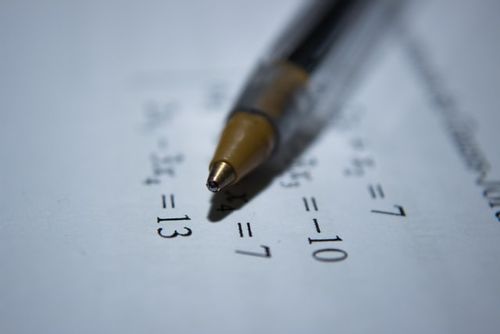FOR AGES 10 YEARS TO 11 YEARS
Parents with children in Year 6 may find themselves wondering 'what exactly is BODMAS?', and so we have created a handy guide to explain what BODMAS means, as well as how and when to use the acronym to complete a calculation.
The BODMAS rule is sure to come up over and over again throughout the curriculum from KS2 onwards, and so parents will find it useful to get to grips with the BODMAS rules. Once understood, parents will be able to help their children to accurately practice their maths, complete their homework and progress at school.

BODMAS is an acronym that has been designed to help children to remember the 'order of operations' - meaning the order in which they should carry out the series of mathematical processes that is presented to them. BODMAS stands for Brackets, Orders, Division/Multiplication, Addition/Subtraction.
Some schools may use the alternative acronym BIDMAS, which has the exact same meaning, but stands for Brackets, Indices, Division/Multiplication, Addition/Subtraction. The American-English version is called PEMDAS, which describes the exact same order of operations but using the American terms: Parenthesis, Exponents, Multiplication/Division, Addition/Subtraction.
The first thing to understand is that there are four main operations within a mathematical calculation - addition, subtraction, multiplication and division.
If a calculation has just one operation, for example, 4 + 12 or 10 + 9 then there is no order of operations. However, if your calculation has more than one operation, for example, 4 + 3 x 2, you can use the BODMAS rule to understand the order of operations - i.e. what order you should perform each element of the calculation.
The second thing you will need to know is what the 'O' in BODMAS stands for - and also the 'I' in BIDMAS. 'Orders' means square roots, square numbers, powers or exponents (i.e. X to the power of Y).

The operations cannot be performed one at a time from left to right, they should instead be done in order of importance, which is the order laid out by the BODMAS acronym. Not that the rule still applies even if there are no brackets in the calculation. In fact, it should be applied to any calculation that has more than 1 operation involved.
If you do not perform the operations in the correct order, you will not get the right answer. To explain this, let's look at some example BODMAS calculations:
Example sum: 11 - 2 x 2
Answer: The right answer is 7
Why? Following the acronym, you must do the multiplication first, followed by the subtraction. If you simply do the sum from left to right, you would get an incorrect answer of 18.
Step One: 11 - (2 x 2 = 4)
Step Two: 11 - 4 = 7

Example sum: 2 x (3 + 4 ) + 52
Answer: The correct answer is 39
Why? The operation in the brackets must be done first, followed by the order (i.e. 5 to the power of 5), then the multiplication, and finally the addition. And so:
Step One: 2 x (3 + 4 = 7) + 52
Step Two: 2 x 7 + (5 x 5 = 25)
Step Three: (2 x 7 = 14) + 25 = 39
Example sum: 10 - 2 + 6 ÷ 3
Answer: The correct answer is 10
Why? The division should be done first - but after that, the addition and subtraction are as important as each other. In this case, after completing the division, you will perform the rest of the sum from left to right:
Step One: 10 - 2 + (6 ÷ 3 = 2)
Step Two: 10 - 2 + 2
Step Three: (10 - 2 = 8) + 2 = 10
Typically, this mathematical rule comes up for the first time in upper Key Stage 2 lessons. However, if younger children can understand, practice and gain confidence in doing individual mathematical operations ahead of Year 6 then they will be able to understand the BODMAS meaning and rules. Feeling confident and being able to accurately perform division, multiplication, addition and subtraction will form a solid basis for the more complicated mathematics of Year 6, including the BODMAS rule.
Read The Disclaimer
At Kidadl we pride ourselves on offering families original ideas to make the most of time spent together at home or out and about, wherever you are in the world. We strive to recommend the very best things that are suggested by our community and are things we would do ourselves - our aim is to be the trusted friend to parents.
We try our very best, but cannot guarantee perfection. We will always aim to give you accurate information at the date of publication - however, information does change, so it’s important you do your own research, double-check and make the decision that is right for your family.
Kidadl provides inspiration to entertain and educate your children. We recognise that not all activities and ideas are appropriate and suitable for all children and families or in all circumstances. Our recommended activities are based on age but these are a guide. We recommend that these ideas are used as inspiration, that ideas are undertaken with appropriate adult supervision, and that each adult uses their own discretion and knowledge of their children to consider the safety and suitability.
Kidadl cannot accept liability for the execution of these ideas, and parental supervision is advised at all times, as safety is paramount. Anyone using the information provided by Kidadl does so at their own risk and we can not accept liability if things go wrong.
Kidadl is independent and to make our service free to you the reader we are supported by advertising.
We hope you love our recommendations for products and services! What we suggest is selected independently by the Kidadl team. If you purchase using the buy now button we may earn a small commission. This does not influence our choices. Please note: prices are correct and items are available at the time the article was published.
Kidadl has a number of affiliate partners that we work with including Amazon. Please note that Kidadl is a participant in the Amazon Services LLC Associates Program, an affiliate advertising program designed to provide a means for sites to earn advertising fees by advertising and linking to amazon.
We also link to other websites, but are not responsible for their content.
Was this article helpful?



Browse Category

We’ll send you tons of inspiration to help you find a hidden gem in your local area or plan a big day out.



Check your inbox for your latest news from us. You have subscribed to:
Remember that you can always manage your preferences or unsubscribe through the link at the foot of each newsletter.